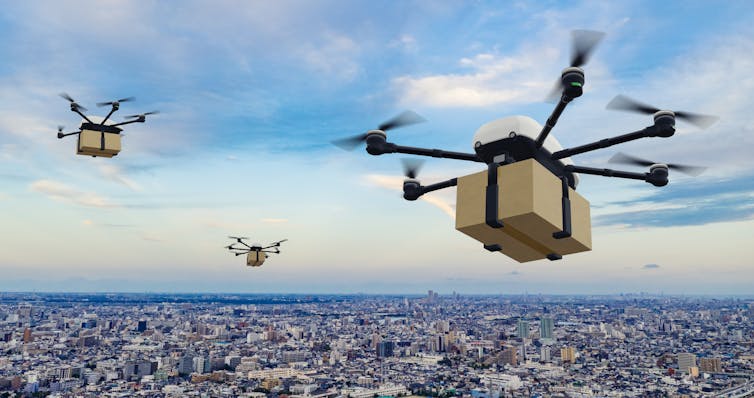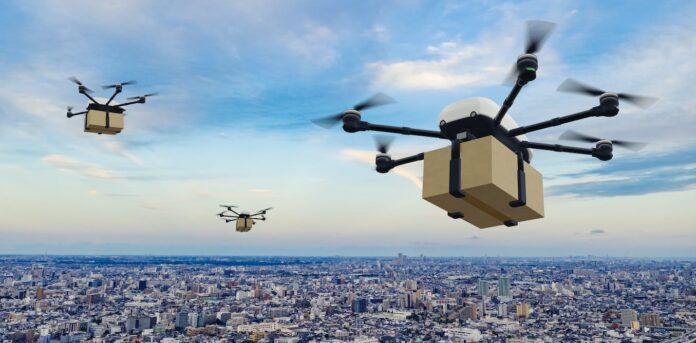Amazon delivery drones: how the sky could be the limit for market dominance

By Renaud Foucart, Lancaster University
Amazon’s latest plan to use drones to deliver packages in the UK by the end of 2024 is essentially a relaunch. It was ten years ago that the company’s founder Jeff Bezos first announced it would fly individual packages through the sky.
Three years later, an impressive promotional video revealed that the project was starting out in the British city of Cambridge. But by 2021, the operation appeared to have come to an abrupt halt.
Now it seems the company was undeterred by that pause. The dream of sending drones to UK homes bearing (not very heavy) items that we cannot wait more than 30 minutes to have is back in play. So, will it work this time?
In the US, progress has been sluggish. Amazon managed a grand total of 100 deliveries in May 2023, in two locations. At one of these locations, in Texas, the company has to pause operations when the temperature gets too high).
Despite this, Amazon plans to launch delivery drones in two new areas – one in the UK and one in Italy (precise locations are yet to be disclosed). It has a new model of drone and a vast logistical network at its disposal.
Aside from these key factors, Amazon may well have been inspired by other companies in the sector. The most obvious example is drone delivery of vital medical supplies.
Zipline started delivering blood and medicine to remote places in Rwanda, and has now expanded to Ghana and the US state of North Carolina. Other companies such as UPS and Google’s Wing have started offering similar services.
But what these success stories have in common is that they are cost-efficient – pharmaceutical products weigh little and are typically expensive enough to justify the use of a drone – and they are focused on areas which are not densely populated.
In contrast, Amazon’s own estimates put the cost of delivering a single package at $484 (£395) today, which it expects to reduce to $63 (£51) by 2025. Offering customers free or cheap drone delivery will be extremely expensive.
Amazon’s solution to this is likely to be the same one it has used so successfully over the last two decades: increasing the scale of its operation. After all, at the start of the century, many wondered how e-commerce could ever be profitable. Now, millions of people buy from Amazon, and that vast number of customers is key to its success.
But Amazon’s business plan seems to rely on dominating the market. And for air deliveries, this means not only dropping packages in rural areas, but being available in cities where more than half the world’s population live.
While it may be easy to convince the residents of a small, low-density area to trial boxes of toothpaste and mouthwash landing in their gardens, it might be much more difficult to persuade residents of apartment buildings to accept drones flying past their windows carrying their neighbour’s delivery of dog biscuits.
Added to this are the laws regulating the use of drones. In the UK, for example, you are not allowed to fly one over congested areas or within 50 metres “of a person, vehicle or building not under your control”.
The higher they fly, the harder they fall
Cities will not simply let commercial drones take to the skies – at least not without charging for the nuisance they generate. They will either ban drones in densely populated areas, or seek further regulation.
If regulation is the route taken, a new hurdle arises which is similar to the allocation of radio waves or mobile phone network licenses – that there will only be enough space for a few operators (sometimes just one).
This allocation usually happens through a bidding process. And studies of auctions of telecom licenses show the importance of involving multiple credible operators. But having different firms winning the right to deliver in different cities could easily reduce the level of reach that Amazon would need to succeed.
An alternative scenario would see a single operator in charge of all drone deliveries. But this raises a familiar economic problem, where natural monopolies emerge in sectors like water provision or other kinds of infrastructure.
For, while society can often benefit from the innovation potential of the private sector, having only one firm in the market opens up the possibility of abuse. For instance, the privatisation of water in the UK has come with a regulator which chooses the prices companies can charge, and never-ending debates on the regulation of sewage and leakages.
Regardless of which company is awarded the business, external regulation usually involves a requirement to treat all consumers fairly and equally – which would mean charging Amazon the same price as its competitors to use the drones.
But fairness and equality are not the goals big companies are interested in when they invest heavily in innovative technology. Their goal is to obtain or keep a dominant position in the market.
Amazon’s current dominance largely relies on its superior logistical operation: it can deliver quickly, cheaply and reliably everywhere. With drone delivery available to other platforms at the same price, Amazon would lose this competitive advantage. So, if it does manage a successful launch this time around, it could well come at the expense of its current dominance as a logistical operation.![]()
Renaud Foucart, Senior Lecturer in Economics, Lancaster University Management School, Lancaster University
This article is republished from The Conversation under a Creative Commons license. Read the original article.



